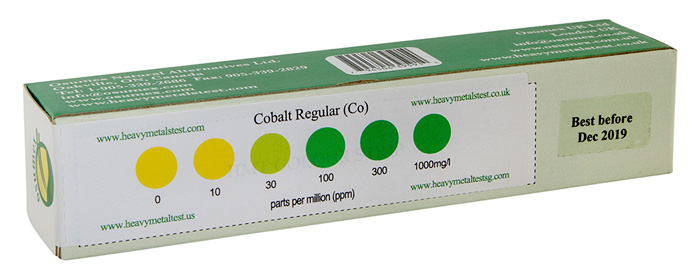Cobalt Kit (Reg)
how to test |
Cobalt Kit (Sen)
how to test |
|
|
| Adrenal Function Urine Test |
| Sulkowitch Urine (Calcium) Test |
|
|
|
COBALT
Number 27 on the "periodic table" of elements
Tests the presence of ions of Cobalt to a high degree of accuracy to
detect contamination in the body and on a wide range of materials in your environment
Cobalt is a naturally occurring element found in rocks, soil, water, plants, and animals. There are non radioactive
and radioactive forms of cobalt.
Non radioactive cobalt, referred to as stable cobalt, is used to produce alloys (mixtures of metals) used in the
manufacture of aircraft engines, magnets, grinding and cutting tools, artificial hip and knee joints. Cobalt compounds
are also used to color glass, ceramics and paints, and used as a drier for porcelein enamel and paints.
The two most commercially important radioactive cobalt isotopes are 60Co (read as cobalt sixty), and 57
Co. 60Co is used as a source of gamma rays for sterilizing medical equipment and consumer products, radiation
therapy for treating cancer patients, for manufacturing plastics, and food irradiation. 57Co is used in medical
and scientific research. It takes about 5.7 years for half of 60Co to give off its radiation and about 272 days
for 57Co; this period of time is called the half-life.
Cobalt is beneficial for humans because it is part of vitamin B12.
Sources
- Cobalt enters the environment from natural sources and the burning of coal or oil or the production of cobalt alloys.
- In the air it will be associated with particles which will settle to the ground within a few days.
- Cobalt released into water or the soil will stick to particles. Some cobalt compounds may dissolve in water.
- Cobalt cannot be destroyed in the environment. It can only change its form or become attached or separated from particles.
Radioactive decay is the only way of decreasing the amount of radioactive cobalt in the environment.
Exposure to cobalt can be in the following manner:
- You can be exposed to low levels of cobalt by breathing air, eating food, or drinking water. Food and drinking water are the largest
sources of exposure to cobalt for the general population.
- Working in industries that make or use cutting or grinding tools; mine, smelt, refine, or process cobalt metal or ores; or that produce
cobalt alloys or use cobalt.
- The general population is rarely exposed to radioactive cobalt unless a person is undergoing radiation therapy. However, workers at
nuclear facilities, irradiation facilities, or nuclear waste storage sites may be exposed to 60Co or 58Co.
Cobalt Toxicity
The Occupational Safety and Health Administration (OSHA) has set a limit of 0.1 milligrams of non-radioactive cobalt per cubic meter of
workplace air (0.1 mg/m3) for an 8-hour workday and 40-hour work week.
The Nuclear Regulatory Commission (NRC) has set annual occupational air limits of 200 uCi for 60Co and 3000 uCi for 57Co.
Cobalt Toxicity Limits
The exact levels where cobalt becomes toxic is not clear. About 10 - 30 mcg. intake daily is probably safe. The theapeutic daily intake is
about 50 ppm. Concentrations in excess of 300 ppm may be cause for concern. This applies only to organic cobalt. There should not be any
concentrations of inorganic cobalt in the body.
Cobalt Toxicity Symptoms
Exposure to high levels of cobalt can result in lung and heart effects and dermatitis. Liver and kidney effects have also been observed in
animals exposed to high levels of cobalt.
Exposure to large amounts of radioactive cobalt or the radiation it emits can damage cells in your body from the radiation. You might also
experience acute radiation syndrome which includes nausea, vomiting, diarrhea, bleeding, coma, and even death.
Non-radioactive cobalt has not been found to cause cancer in humans or animals following exposure in food or water. Cancer has been shown,
however, in animals who breathed cobalt or when cobalt was placed directly into the muscle or under the skin. Based on the laboratory animal
data, the International Agency for Research on Cancer (IARC) has determined that cobalt and cobalt compounds are possibly carcinogenic to
humans.
Exposure to high levels of cobalt radiation can cause changes in the genetic materials within cells and may result in the development of
some types of cancer.
Exposure to cobalt radiation can also result in developmental effects.
Check out cobalt levels in your body with our easy to use, home-based,
HMT Cobalt Test kit
 
Sample of a HMT Cobalt Regular Test kit
 
Sample of a HMT Cobalt Sensitive Test kit

The above information is provided for general
educational purposes only. It is not intended to replace competent
health care advice received from a knowledgeable healthcare professional.
You are urged to seek healthcare advice for the treatment of any
illness or disease.
Health Canada and the FDA (USA) have not evaluated these
statements. This product is not intended to diagnose, treat, cure, or prevent
any disease.
|


